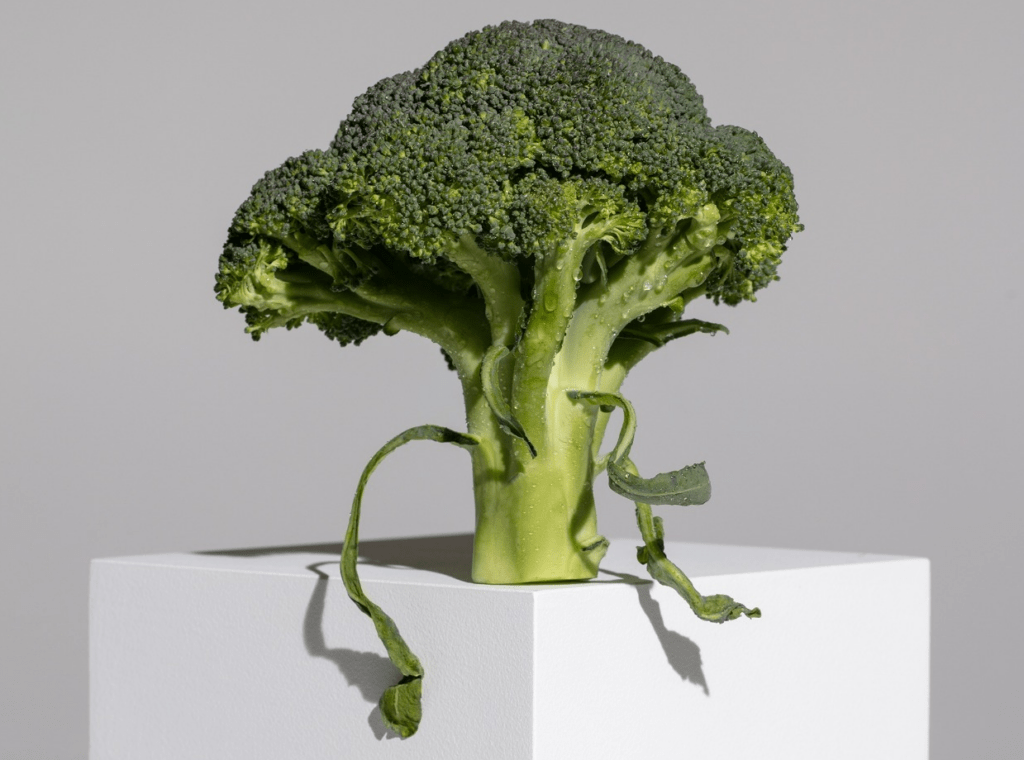Sulforaphane – a powerful antioxidant Aetas Protocols
Sulforaphane is a natural compound that has garnered significant attention for its numerous health benefits, including a potential life-extending effect. In this article, you will learn more about what sulforaphane is, how it can contribute to optimized health, and why sulforaphane should be a regular part of your daily routine.

What is Sulforaphane?
Sulforaphane is a phytochemical (phyto means plant in Greek) found in cruciferous vegetables such as broccoli, kale, and Brussels sprouts, with the highest concentration found in broccoli sprouts. Broccoli sprouts contain 10-100 times more sulforaphane than mature broccoli. In plants, the purpose of phytochemicals is to protect the plant. Sulforaphane is the hydrolyzed form of the glucosinolate glucoraphanin, which is hydrolyzed by the enzyme myrosinase. Myrosinase is present in the plant itself and is released through mechanical breakdown of the plant, such as when the plant is blended, chopped, or chewed. Myrosinase is also a part of our microbiome. When broccoli sprouts are broken down, either in the kitchen or in the mouth, myrosinase is released, aiding in the formation of sulforaphane. Further conversion of glucoraphanin can take place in the gastrointestinal tract, increasing the yield of sulforaphane.1Santín-Márquez, R., Alarcón-Aguilar, A., López-Diazguerrero, N. E., Chondrogianni, N., & Königsberg, M. (2019). Sulforaphane – role in aging and neurodegeneration. GeroScience, 41(5), 655–670. https://doi.org/10.1007/s11357-019-00061-7.
Sulforaphane’s Effects in the Body
With over 2000 clinical studies on sulforaphane, there is substantial evidence that sulforaphane can exert both anti-inflammatory and antioxidant effects, which can have beneficial impacts on various chronic and acute diseases, such as cancer, Alzheimer’s disease, inflammation, and various metabolic conditions. Below, you can read more about the potential health-promoting effects of sulforaphane.
Sulforans virkning mod kræft
Several studies have shown that the consumption of cruciferous vegetables, particularly broccoli, can have a positive effect on delaying and preventing cancer.
A study on a group of men showed that those who ate ≥3 servings of cruciferous vegetables had a 41% reduced risk of prostate cancer compared to those who ate less than 1 serving per week.2Cohen, J. H., Kristal, A. R., & Stanford, J. L. (2000). Fruit and vegetable intakes and prostate cancer risk. Journal of the National Cancer Institute, 92(1), 61–68. https://doi.org/10.1093/jnci/92.1.61.
Additionally, studies show that a high intake of cruciferous vegetables reduces the risk of developing bladder cancer and breast cancer.4,Michaud, D. S., Spiegelman, D., Clinton, S. K., Rimm, E. B., Willett, W. C., & Giovannucci, E. L. (1999). Fruit and vegetable intake and incidence of bladder cancer in a male prospective cohort. Journal of the National Cancer Institute, 91(7), 605–613. https://doi.org/10.1093/jnci/91.7.605.5Bosetti, C., Filomeno, M., Riso, P., Polesel, J., Levi, F., Talamini, R., Montella, M., Negri, E., Franceschi-Messant, S., & La Vecchia, C. (2012). Cruciferous vegetables and cancer risk in a network of case–control studies. Annals of Oncology, 23(8), 2198–2203. https://doi.org/10.1093/annonc/mdr604.
Existing research suggests that a higher intake of cruciferous vegetables, and thus sulforaphane, can not only play a role in reducing the risk of developing certain types of cancer but also slow disease progression.
Sulforaphane’s Detoxifying Effect
Sulforaphane has been shown to be an effective activator of phase II enzymes in the liver, which help detoxify potentially toxic and carcinogenic substances that enter the body. Benzene is a carcinogenic substance that can cause, among other things, leukemia and lymphoma. The primary sources of benzene exposure are car exhaust, air pollution, and smoking, including passive smoking.
In a study conducted in Qidong, China, an area with high air pollution, the detoxifying effect of sulforaphane was investigated. Over a period of 12 weeks, a group of participants received a special drink made from broccoli sprouts with high levels of glucoraphanin and sulforaphane. Their urinary excretion of toxic substances, including benzene, was examined. The results showed that after just one day, the urinary excretion of benzene increased by up to 61% and remained higher than the control group’s levels throughout the 12 weeks.6Egner, P. A., Chen, J., Zarth, A. T., Ng, D. K., Wang, J., Kensler, K. H., Jacobson, L. P., Muñoz, A., Johnson, J. L., Groopman, J. D., Fahey, J. W., Talalay, P., Zhu, J., Chen, T., Qian, G., Carmella, S. G., Hecht, S. S., & Kensler, T. W. (2014). Rapid and sustainable detoxication of airborne pollutants by broccoli sprout beverage: results of a randomized clinical trial in China. Cancer Prevention Research, 7(8), 813–823. https://doi.org/10.1158/1940-6207.capr-14-0103.
This is a significant effect, illustrating that sulforaphane could potentially help prevent the development of various types of cancer by increasing the excretion of toxic and carcinogenic substances.
Sulforaphane’s Importance for Cardiovascular Health
Cardiovascular diseases rank high on the list of deadly illnesses. Cruciferous vegetables and sulforaphane have both shown positive effects on these diseases. A study on “all-cause mortality” found that a group with a high intake of cruciferous vegetables had approximately 30% lower mortality caused by cardiovascular diseases.7Zhang, X., Shu, X., Xiang, Y., Yang, G., Li, H., Gao, J., Cai, H., Gao, Y., & Zheng, W. (2011). Cruciferous vegetable consumption is associated with a reduced risk of total and cardiovascular disease mortality. The American Journal of Clinical Nutrition, 94(1), 240–246. https://doi.org/10.3945/ajcn.110.009340. Several studies also show that people who consume more cruciferous vegetables have a lower risk of developing cardiovascular diseases, heart attacks, and stroke.8Cornelis, M. C., El-Sohemy, A., & Campos, H. (2007). GSTT1 genotype modifies the association between cruciferous vegetable intake and the risk of myocardial infarction. The American Journal of Clinical Nutrition, 86(3), 752–758. https://doi.org/10.1093/ajcn/86.3.752.
In a randomized clinical study, three groups of type 2 diabetics received either 10 g of broccoli sprout powder, 5 g of broccoli sprout powder, or a placebo daily for four weeks. A range of biomarkers were measured, including the atherogenic index of plasma (AIP), which is a specific biomarker used to predict the development of cardiovascular diseases. The group that received 10 g daily had reduced their serum triglyceride levels by approximately 18%, reduced fasting blood glucose by nearly 20%, and had a 52% reduction in AIP.9Bahadoran, Z., Mirmiran, P., Hosseinpanah, F., Rajab, A., Asghari, G., & Azizi, F. (2012). Broccoli sprouts powder could improve serum triglyceride and oxidized LDL/LDL-cholesterol ratio in type 2 diabetic patients: A randomized double-blind placebo-controlled clinical trial. Diabetes Research and Clinical Practice, 96(3), 348–354. https://doi.org/10.1016/j.diabres.2012.01.009.
Based on the existing evidence, sulforaphane can potentially reduce risk factors for cardiovascular diseases and help prevent the development of these conditions.
Sulforaphane’s Effects on Neurodegenerative Diseases
The treatment of neurodegenerative diseases remains a challenge, and it is difficult to administer medications due to the blood-brain barrier. This barrier, which mainly consists of endothelial cells in the brain’s blood vessels, protects the brain from harmful substances and pathogens. While this is an important function, it also creates problems when attempting to treat brain diseases, as medications need to be able to pass through this highly impermeable barrier.
A study in mice has shown that sulforaphane is capable of crossing the blood-brain barrier and exerting a beneficial effect in the brain.10Jazwa, A., Rojo, A. I., Innamorato, N. G., Hesse, M., Fernández-Ruiz, J., & Cuadrado, A. (2011). Pharmacological targeting of the transcription factor NRF2 at the basal ganglia provides disease modifying therapy for experimental parkinsonism. Antioxidants & Redox Signaling, 14(12), 2347–2360. https://doi.org/10.1089/ars.2010.3731. Additionally, studies have shown that sulforaphane improves memory in mice with Alzheimer’s disease, reduces symptoms in mice with Parkinson’s disease, and accelerates the removal of protein aggregates in mice with Huntington’s disease.11,Kim, H. V., Kim, H. Y., Ehrlich, H. Y., Choi, S. Y., Kim, D. J., & Kim, Y. (2012). Amelioration of Alzheimer’s disease by neuroprotective effect of sulforaphane in animal model. Amyloid, 20(1), 7–12. https://doi.org/10.3109/13506129.2012.75136.12,Morroni, F., Tarozzi, A., Sita, G., Bolondi, C., Moraga, J. M. Z., Cantelli-Forti, G., & Hrelia, P. (2013). Neuroprotective effect of sulforaphane in 6-hydroxydopamine-lesioned mouse model of Parkinson’s disease. Neurotoxicology, 36, 63— 71. https://doi.org/10.1016/j.neuro.2013.03.00413Liu, Y., Hettinger, C. L., Zhang, D., Rezvani, K., Wang, X., & Wang, H. (2014). Sulforaphane enhances proteasomal and autophagic activities in mice and is a potential therapeutic reagent for Huntington’s disease. Journal of Neurochemistry, 129(3), 539–547. https://doi.org/10.1111/jnc.12647.
By being able to cross the blood-brain barrier and improve symptoms in animal models, it suggests that sulforaphane may have positive effects on neurodegenerative diseases and their progression.
Can Sulforaphane Extend Life?
Existing research shows that sulforaphane potentially has many positive effects, but is there a connection between sulforaphane intake and lifespan? Unfortunately, no human studies directly show a correlation, but there have been studies in animals. The roundworm C. elegans is often used in aging research because it has an average lifespan of about four weeks. In one study, C. elegans were given different concentrations of sulforaphane throughout their life. The result was an increased lifespan of up to 18% in those that received sulforaphane compared to those that did not receive sulforaphane.14Qi, Z., Ji, H., Le, M., Li, H., Wieland, A., Bauer, S., Liu, L., Wink, M., & Herr, I. (2021). Sulforaphane promotes C. elegans longevity and healthspan via DAF-16/DAF-2 insulin/IGF-1 signaling. Aging, 13(2), 1649–1670. https://doi.org/10.18632/aging.202512. One of the key markers of aging is chronic inflammation, and reducing the amount of chronic inflammation in the body can increase the likelihood of a longer life. Additionally, lower levels of chronic inflammation are associated with prolonged physical functionality and cognitive abilities.15Arai, Y., Takayama, M., Gondo, Y., Inagaki, H., Yamamura, K., Nakagawa, T., … & Hirose, N. (2015). Inflammation, but not telomere length, predicts successful ageing at extreme old age: A longitudinal study of semi-supercentenarians. EBioMedicine, 2(10), 1549-1558. https://doi.org/10.1016/j.ebiom.2015.09.001. Although it has not been directly proven that sulforaphane can extend human life, much evidence suggests it could have a positive effect due to sulforaphane’s impact on inflammation. Sulforaphane achieves both anti-inflammatory and antioxidant effects through its activation of Nuclear factor erythroid 2-related factor 2 (NRF2).
Sulforaphane’s Effect on NRF2
Reactive oxygen species (ROS) are constantly formed in the body, leading to oxidative stress. In normal cells, ROS are produced in a controlled manner and have some useful functions, including acting as important signaling molecules that regulate processes such as cell division, inflammation, immune function, autophagy, and stress response. Conversely, uncontrolled production of ROS can lead to oxidative stress, which impairs cell function and contributes to the development of cancer, chronic diseases, and toxicity.16Ma, Q. (2013). Role of Nrf2 in oxidative stress and toxicity. Annual Review of Pharmacology and Toxicology, 53, 401-426. https://doi.org/10.1146/annurev-pharmtox-011112-140320.
Sulforaphane is the most potent compound that activates the NRF2 signaling pathway, thereby activating many protective proteins in the body. NRF2 is a transcription factor that controls which proteins are formed from your DNA and is significant for the expression of over 200 genes, including antioxidant and anti-inflammatory genes, as well as genes that can inactivate harmful substances. In fact, NRF2 controls 3-5% of all human cellular proteins. When the amount of NRF2 increases, it leads to the formation of more antioxidant proteins, which are essential for combating disease, inflammation, and other cellular damage resulting from ROS. Through NRF2 activation, proteins are produced that counteract the harmful effects of ROS and their toxic byproducts. NRF2 can even help the body repair itself after the stress is gone.17,Saha, S., Buttari, B., Panieri, E., Profumo, E., & Saso, L. (2020). An overview of Nrf2 signaling pathway and its role in inflammation. Molecules, 25(22), 5474. https://doi.org/10.3390/molecules25225474.18,Buendia, I., Michalska, P., Navarro, E., Gameiro, I., Egea, J., & León, R. (2016). Nrf2-ARE pathway: An emerging target against oxidative stress and neuroinflammation in neurodegenerative diseases. Pharmacology & Therapeutics, 157, 84-104. https://doi.org/10.1016/j.pharmthera.2015.11.003.19,Dinkova-Kostova, A. T., Fahey, J. W., Kostov, R. V., & Kensler, T. W. (2017). KEAP1 and done? Targeting the NRF2 pathway with sulforaphane. Trends in Food Science & Technology, 69, 257-269. https://doi.org/10.1016/j.tifs.2017.02.002.20Kensler, T. W., Wakabayashi, N., & Biswal, S. (2012). Keap1–Nrf2 signaling: A target for cancer prevention by sulforaphane. In D. V. Singh (Ed.), Oxidative Stress and Disease (Vol. 128, pp. 163-177). Springer. https://doi.org/10.1007/128_2012_339.
Sulforaphane’s Anti-inflammatory Effect
Sulforaphane also promotes an anti-inflammatory effect through the NRF2 signaling pathway. Sulforaphane has been shown to inhibit Nuclear factor kappa-light-chain-enhancer of activated B cells (NF-κB) through the activation of NRF2. NF-κB is a transcription factor that regulates the expression of several pro-inflammatory genes, including cytokines, chemokines, and pro-inflammatory factors. When NF-κB is inhibited, these pro-inflammatory genes are not expressed, resulting in an anti-inflammatory effect.21Jiang, X., Liu, Y., Ma, L., Ji, R., Qu, Y., Xin, Y., … & Ma, Y. (2018). Chemopreventive activity of sulforaphane. Drug Design, Development and Therapy, 12, 2905-2913. https://doi.org/10.2147/DDDT.S100534.
Studies in humans have shown that there is a correlation between increased intake of cruciferous vegetables and reduced levels of pro-inflammatory cytokines in the blood, such as tumor necrosis factor-alpha and interleukin-6, which typically play a role in promoting inflammation in the body.22,Mirmiran, P., Bahadoran, Z., Hosseinpanah, F., Keyzad, A., & Azizi, F. (2012). Effects of broccoli sprout with high sulforaphane concentration on inflammatory markers in type 2 diabetic patients: A randomized double-blind placebo-controlled clinical trial. Journal of Functional Foods, 4(4), 837-841. https://doi.org/10.1016/j.jff.2012.05.016.23Navarro, S. L., Li, F., Lampe, J. W., & Schwarz, Y. (2014). Cruciferous vegetables have variable effects on biomarkers of systemic inflammation in a randomized controlled trial in healthy young adults. Journal of Nutrition, 144(11), 1850-1857. https://doi.org/10.3945/jn.114.198036. As the body ages, the need for NRF2 activation increases to maintain health, but in reality, the amount of NRF2 that gets activated naturally decreases with age. This means that no matter how healthy you are and how many antioxidant-rich foods you eat, your body will eventually not be able to produce enough neutralizing antioxidants to prevent oxidative stress. Therefore, it is important to support the body’s ability to activate NRF2.24Zhou, L., Zhang, H., Davies, K. J. A., & Forman, H. J. (2018). Aging-related decline in the induction of Nrf2-regulated antioxidant genes in human bronchial epithelial cells. Redox Biology, 14, 35-40. https://doi.org/10.1016/j.redox.2017.08.018.
By regularly consuming sulforaphane, you can help the body maintain a healthy balance of the amount of NRF2 present in the body.
Supplementation with Sulforaphane
To achieve all the health-promoting benefits of sulforaphane, it is necessary to consume a certain amount of sulforaphane regularly. The easiest way to achieve this is by taking sulforaphane as a supplement. It is also possible to consume sulforaphane through your diet, but it can be challenging to intake the optimal amount every day. This is because the concentration of glucoraphanin, which is converted to sulforaphane in foods like broccoli, depends on many factors such as genetics, growing location, and cultivation method.25,Tříska, J., Vrchotová, N., Šindelářová, K., Zdráhal, Z., & Smutná, P. (2021). Factors influencing sulforaphane content in broccoli sprouts and subsequent sulforaphane extraction. Foods, 10(2), 263. https://doi.org/10.3390/foods10020263.26Yagishita, Y., Fahey, J. W., Dinkova-Kostova, A. T., & Kensler, T. W. (2019). Broccoli or sulforaphane: Is it the source or dose that matters? Molecules, 24(19), 3593. https://doi.org/10.3390/molecules24193593.
Below, you can read about three ways to increase your intake of sulforaphane.
Eat raw cruciferous vegetables
Raw cruciferous vegetables contain higher levels of glucoraphanin and thus yield more sulforaphane. Broccoli is the vegetable with the highest glucoraphanin content. A study showed that raw broccoli resulted in about 10 times more sulforaphane in the blood compared to cooked broccoli.27Vermeulen, M., Klöpping-Ketelaars, I. W. A. A., Van Den Berg, R., & Vaes, W. H. J. (2008). Bioavailability and kinetics of sulforaphane in humans after consumption of cooked versus raw broccoli. Journal of Agricultural and Food Chemistry, 56(22), 10505-10509. https://doi.org/10.1021/jf801989e.
When broccoli or other vegetables are exposed to high heat, it leads to the inactivation of the enzyme myrosinase, preventing the formation of sulforaphane.
Grow your own broccoli sprouts
The yield of sulforaphane is highest in the early stages of the plant. In broccoli sprouts, there is 10-100 times more glucoraphanin than in mature broccoli. You can easily grow your own broccoli sprouts by following our guide here. You should consume about 100 grams per day to achieve an effect.
What’s the best way to boost your sulforaphane intake?
Sulforaphane itself is highly reactive and unstable, but its precursor, glucoraphanin, is much more stable. The richest natural source of glucoraphanin is broccoli sprouts. You can also get it from supplements made with broccoli seed extract. For the best results, these supplements should be taken with a source of myrosinase, like mustard seed powder, to help convert glucoraphanin into active sulforaphane.
KEY TAKEAWAY
Sulforaphane is the most potent activator of NRF2 in the body, a process that results in powerful anti-inflammatory and antioxidant effects. Research has shown that there is a correlation between high intake of cruciferous vegetables, especially broccoli sprouts, and a reduced risk of developing certain types of cancer and cardiovascular diseases, as well as increased excretion of toxins such as benzene. Sulforaphane has a potential life-extending effect by reducing inflammation, oxidative stress, and the risk of various diseases. To achieve these benefits, it is necessary to consume sulforaphane daily.
LITTERATURE REFERENCES
Make your move
Optimise your health so that you live a longer and healthier life
Aetas is a clinic for precision medicine and molecular laboratory. We specialise in Longevity, evidence-based health optimization and preventive treatments.
Enquire Now








